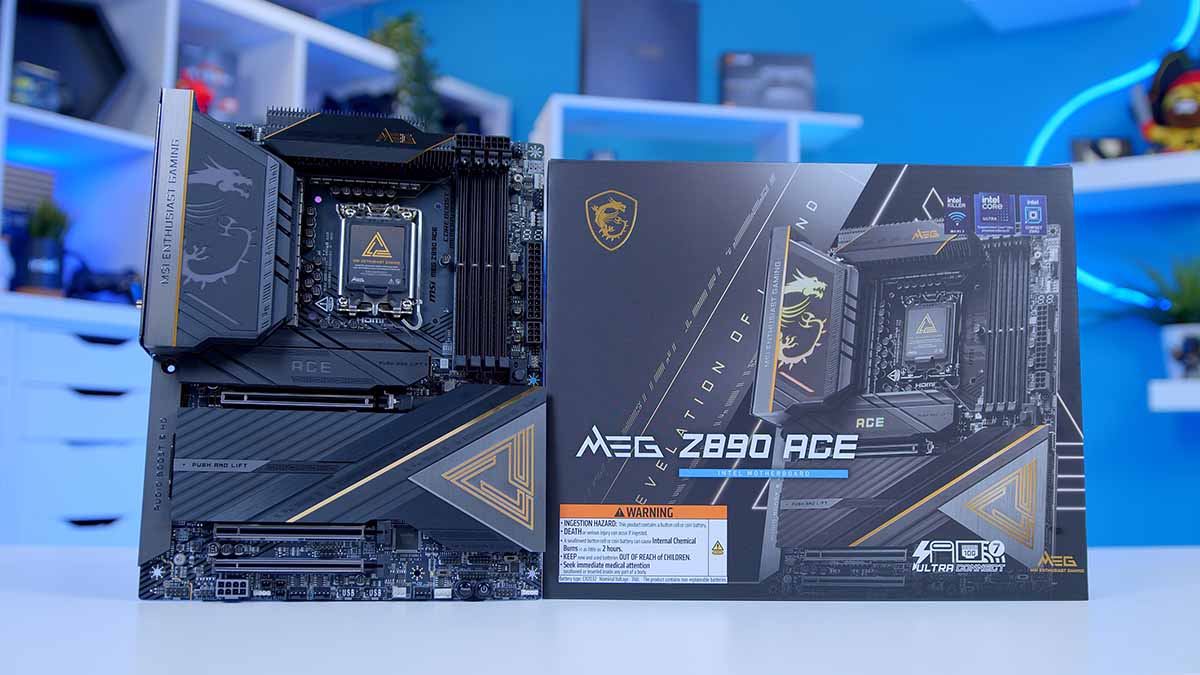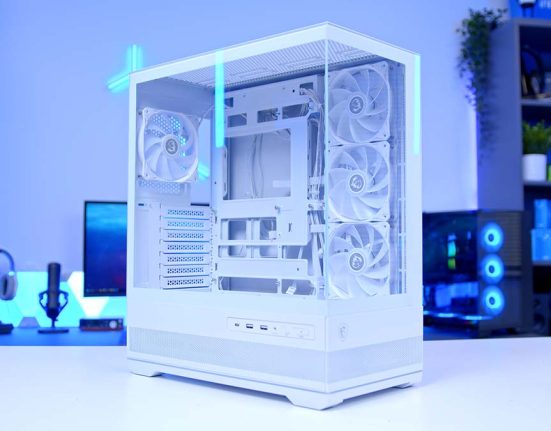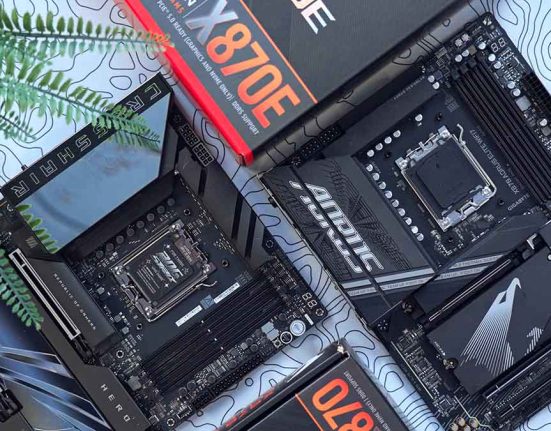The MSI MEG Z890 ACE is a flagship motherboard launched with the Intel Z890 chipset, which pairs alongside the Intel Core Ultra CPUs. As one of the pricier boards on the market, the MSI MEG Z890 ACE brings top-end features to the table, such as a 24+2+1+1 VRM power phase design built to handle intense overclocking, vast high-speed IO for those looking to transfer hefty files, and massive amounts of Gen5 storage to host all of your favourite games and applications. We’ve tested and analysed this board rigorously to see how it performs and to determine what features are available compared to the previous generation.
The LGA1851 platform is a period of refinement for Intel. From our other motherboard reviews, we haven’t seen any new features introduced compared to 14th-Gen options. However, many current-gen design qualities, such as RAM and CPU overclocking, Gen5 compatibility and USB bandwidth, have received some solid improvements. Builders have many configurations available when assembling a system, especially for those configuring a top-end PC.
This motherboard review article thoroughly examines the MSI MEG Z890 ACE, its key specs, box accessories, design, connectivity and expansion, and internal headers.
Buy the MSI MEG Z890 ACE on:
Specification
At a glance, the MEG Z890 ACE and the Z790 ACE MAX specs aren’t drastically different. There’s a noticeable improvement to overclocking capabilities across the board, with the Z890 offering up to 9200MT/s speeds on the RAM and a 24+2+1+1 VRM power phase design for extreme overclocking on the CPU. The Z890 ACE adds an extra power phase, but for the most part, both boards have similar performance capabilities.

Storage and GPU support are the same across both generations. The Z890 ACE supports dual Gen5 GPU slots, running at x8 speeds if both are engaged. There’s only one Gen5 slot for storage, while the remaining four are Gen4. Ultimately, I feel the Gen5 support should be more robust for a motherboard priced this high. The Z890 ROG MAXIMUS, which is similarly specced, offers more Gen5 storage out of the box despite coming in at a similar price to the ACE.
The type of available USBs isn’t hugely different from what’s on the Z790 ACE MAX. On the front, both boards share most of the same headers: two USB 2.0, two USB 3.2 Gen1 Type-A headers, and USB 3.2 Gen2x2 Type-C, but the Z790 ACE MAX has an additional USB 3.2 Gen2x2 Type-C. The spec is similar on the rear, but the Z890 ACE wins out due to having more ports. On the rear of the Z890 ACE, there are fifteen ports, compared to the ten on the Z790 ACE MAX. The MEG Z890 ACE comprises two Thunderbolt 4 Type-C, eleven USB 3.2 Gen2 Type-A, and two USB 3.2 Gen2 Type-C, which is an excellent selection.
| Specification | MSI MEG Z890 ACE |
|---|---|
| Form Factor | ATX |
| Supported Memory | 256GB DDR5 9200MT/s |
| PCI-E x16 Slots | 2 x PCI-E 5.0 1 x PCI-E 4.0 |
| PCI-E x4 Slots | 1 x PCI-E 5.0 4 x PCI-E 4.0 |
| VRM Power Phases | 24+2+1+1 |
| Front IO | 2 x USB 2.0 2 x USB 3.2 Gen1 Type-A 1 x USB 3.2 Gen2x2 Type-C |
| Rear IO | 2 x Thunderbolt4 Type-C 11 x USB 3.2 Gen2 Type-A 2 x USB 3.2 Gen2 Type-C |
| Audio | 1 x Optical S/PDIF 2 x Audio Jacks |
| Networking | 10 Gigabit LAN WiFi 7 |
The MEG Z890 ACE features two 3.5mm jacks and an optical S/PDIF for audio. As mentioned in some of our other motherboard reviews, top-end boards should have a better audio selection, but adding optical S/PDIF is a solid value-add. Regarding networking, enthusiasts can leverage a 10 Gigabit LAN port or WiFi7. Seeing dual-LAN on a board this expensive would have been nice, opening up options for those with home server setups. However, 10 Gigabit LAN and WiFi7 will suffice for most builders.
What’s in the Box?
With all of our motherboard reviews, before delving into the design, we like to look at the box accessories to see what extra goodies the manufacturer has included alongside the board. As a top-end offering from MSI, it’s fair to expect a reasonable amount of additional gadgets and cables in the box.
First up is the WiFi 7 antenna. If you’ve looked at any of our X870 coverage, you’ll know what these antennas look like. They’re pretty standard in terms of the design, but they feature a snap-in connector instead of screws which makes the antenna more straightforward to install and remove.

This board comes with a blank USB stick. Some manufacturers will install drivers here, which makes installing things like WiFi easier. We recommend keeping this for drivers or using it as a Windows USB for future troubleshooting issues.

There is a range of extra cables included in the box worth noting. MSI includes a few RGB extension cables, one 3-pin and one 4-pin for those with addressable and non-addressable RGB. A female RGB extension cable also provides more slack for those installing a cooler or fans.

This board also has four SATA data cables, two DisplayPort to Mini Displayport cables, a thermistor cable for accurately measuring temperature data, the EZ front panel cable, and a JAF1 cable used for MSI coolers and fans, which streamlines power and RGB into one header.

Last but not least, there’s a quick installation guide that walks through the steps to build a PC. You can also find some stickers to add some novelty to your build and M.2 EZ clip/standoff set; there’s a small key to remove the EZ clip with minimal hassle, which saves using pliers or something similar.

MSI MEG Z890 ACE Design
As one of the most expensive motherboards on the market, the MSI MEG Z890 ACE is designed to be one of the more sophisticated-looking options. It is primarily black with some contrasting grey towards the bottom right heatsink. Across the heatsinks is the ‘MEG’ livery. You’ll also find that the board is covered in a golden coating that oozes sophistication. MSI is targeting the premium market here, and I’d say that they’ve succeeded.

There are two areas of RGB lighting. The first is on top of the rear IO heatsink, in which the MSI dragon logo shines brightly with customisable lighting effects. The second is smaller, in the middle of the main M.2 heatsink just underneath the CPU socket. You’d expect a board like this to have plenty of RGB lighting, but the gold etchings across the PCB demonstrate how premium this board is compared to other options.

I’m a big fan of the overall design. Previous MSI MEG boards have always hit the market when it comes to aesthetics, and this Z890 option definitely follows suit. The only minor caveat is that there isn’t a white version. A white and gold MEG Z890 ACE motherboard would look gorgeous and open up choices for those building a white-themed gaming PC.

However, I think the black and gold design looks excellent, and I can certainly understand how it would appeal to those building an enthusiast gaming PC with a darker style.
Connectivity Options
Graphics Card Slots
As mentioned in the specs section of this article, the MSI MEG Z890 ACE is pretty similar to its Z790 counterpart, the MEG Z790 ACE MAX. With the release of 14th-Gen, a range of boards received some upgrades, and the ACE SKU from MSI was one of them. This means both boards share the same dual-Gen5 configuration, with slot one running at x16 speeds and slot two at x8.

It’s worth noting that this Z890 motherboard is one of the few options that features the Z890 supplemental 8-pin power header. These are designed for heavy computing tasks leading to high-power excursions.

M.2 Slots
Unfortunately, storage is another area on this motherboard that hasn’t seen much of an upgrade, even with the new platform. The MSI MEG Z890 ACE has five slots. The topmost is Gen5, underneath the tool-less heatsink. MSI has employed its latch-and-click system, so a screwdriver isn’t necessary to install any drives on this board.

The rest of the SSD slots are underneath the larger heatsink, which uses tool-less latches to save time when building a PC.

RAM DIMMs
This board supports a maximum of 256GB of RAM (four 64GB sticks). The MEG Z890 ACE caps out at 9200MT/s on the speed front, a significant leap over the 7800MT/s on the Z790 ACE MAX. The DIMM slots have one push tab on the bottom of each slot, which makes them easier to install.

Rear IO
I have to admit, the sheer amount of rear IO on the MEG Z890 ACE is impressive. MSI has put the maximum number of USBs they can on this board, meaning there are fifteen high-speed ports in total. As a top-end board, it’s no surprise to see Thunderbolt 4 Type-C and a range of buttons that can assist with troubleshooting, such as BIOS Flash and Clear CMOS.

As mentioned, I am slightly disappointed that this board doesn’t support a dual LAN configuration. It makes more sense to me to have two 5 Gigabit ports instead of one ten, as this would allow a stable connection for a home server and general internet usage. However, with a supporting router, WiFi7 is pretty stable. The audio selection is relatively basic, with two 3.5mm jacks and S/PDIF. It’s great to see the optical port, but the audio on this board doesn’t cater to those with complex speaker setups. The connectivity on the rear IO is more than adequate for most PC building enthusiasts, but some adjustments would allow it to cover all bases.
Internal Headers
CPU and Motherboard Power
Moving onto the internal headers, the Z890 ACE doesn’t offer anything out of the ordinary regarding power configuration. This board features two 8-pin EPS CPU headers. They’re located towards the top-right instead of the top-left, likely due to the size of the heatsink covering the VRMs.

Motherboard power is pretty standard, supporting the 24-pin connector. It’s worth noting that the 6-pin PCI-E underneath motherboard power isn’t for help with overclocking. It’s to achieve 60W power delivery over the front USB Type-C header.

Front USB Headers & SATA
The selection of front USB headers is pretty much the same as what’s available on the Z790 ACE MAX. There are five in total, two USB 2.0, two USB 3.2 Gen1 Type-A, and one USB 3.2 Gen2x2 Type-C. The USB-C and 3.0 headers are right-angled and situated towards the bottom left of the motherboard. This is also coincidentally where the four SATA ports are for those with any SATA-based storage.

The remaining two USB 2.0 headers are at the motherboard’s bottom centre, underneath the PCI-E 4.0 x16 slot. These headers don’t feature any protective covering around them, so so be cautious when plugging them in. It would be nicer to see an additional USB 2.0 header because many modern fans and coolers use USB 2.0 to interface with software. But two will suffice for most builders.

Pump and Fan Headers
There’s a decent selection of pump and fan headers on this motherboard. There are five ‘SYS_FAN’ headers, two ‘Combo_Fan’ headers, and one ‘CPU_FAN’ header. They’re pretty dispersed around the motherboard. At the top left is ‘SYS_Fan1’, while ‘CPU_Fan’ is to the right of this, located to the main CPU headers. Below is an ‘AIO_Pump’ header and an additional ‘CHA_Fan’ header.

The rest of the 4-pin PWM headers are at the bottom of the PCB, just to the left of the power button. All the fan headers are 4-pin PWM, a universal standard for most fans and coolers. It’s great to see such a versatile selection of PWM headers, as it provides plenty of options for those with custom loops.

RGB Headers
All the RGB connections on this motherboard are addressable, which means they use the 3-pin standard. It would be great to see more than three of them, but with some splitters and clever wiring, three will be ample for most builders and enthusiasts. One is located towards the top right of the Z890 ACE near CPU power. The other two line outer width of the PCB; one is at the bottom right, and the other is close to the bottom left.

Building with the MEG Z890 ACE
Building a PC has become much more manageable with the vast majority of the new motherboards. The MSI MEG Z890 ACE features extensive tool-less features streamlining the building process while minimising the use of any tools. More specifically, it’s great to see the use of a latch system instead of screws to secure the larger heatsinks in place.
This board also features a hefty metal backplate, which provides more stability for the PCB and reduces the number of nicks and scratches that can occur when building PCs regularly. I’m a big fan of MSI’s approach with the MEG Z890 ACE; it’s designed to simplify and hassle-free the end-user’s building experience. I’m glad these new boards incorporate simple but functional mechanisms to make building a PC easier. Here’s hoping that the next generation of motherboards follows suit.
Features We Like
Ideal for Overclocking
The MSI MEG Z890 ACE is one of the best options for overclocking. Its 24+2+1+1 VRM power phase design gives it an edge against other boards and can consistently deliver vast amounts of power to the CPU. With plenty of cooling around the VRMs, thermals will remain nice and low even during challenging workloads.

Massive Amount of Rear IO
Despite my reservations about the networking and audio on this motherboard, I must admit the amount of IO is impressive. There are no USB 2.0 ports in sight, and the fifteen ports on this board are more than ample for those shifting around large files or with plenty of peripherals.

Features We Don’t Like
Lack of Gen5 SSD Slots
One of this board’s more significant caveats is its lack of Gen5 support. As a flagship Z890 motherboard, the MEG Z890 ACE should cater to those with plenty of Gen5 SSD storage. MSI doesn’t have much of an excuse compared to a board like the Z890 ROG MAXIMUS, which is similarly priced.

No Dual LAN Support
As mentioned, the MSI MEG Z890 ACE only features a 10 Gigabit LAN port. While it’s great to see a high-speed port, I feel the Z890 ACE would benefit from having two ports, catering to those with complex network setups or home servers.

Conclusion
MSI MEG Z890 ACE
Product Name: MEG Z890 ACE
Brand: MSI
-
Features
-
Design
-
Performance
-
Value For Money
Summary
The MSI MEG Z890 ACE is a solid motherboard. The more prominent inclusion of usability features adds excellent value, streamlining the building process. The higher VRM power phases make this board a solid choice for top-end enthusiast systems, especially if you plan to do intense overclocking. There’s a well-rounded set of USB ports on offer, and I think the design of the Z890 ACE is sophisticated and looks great.
The biggest problem with this board is how similar it is to the MEG Z790 ACE MAX. Many of the features across both boards are the same, which includes the lacklustre support for Gen5 SSDs, which puts into question the value of jumping platforms. While I appreciate that this is the first generation of boards on the LGA1851 platform, there are some kinks to work out. Still, as a $700 motherboard, I feel the Z890 ACE could offer more to separate it from its Z790 counterpart, making the platform leap worth it for those with reservations.
Pros
✅ Ideal for overclocking
✅ Bountiful USB ports
✅ Usability features
Cons
❌ Lacks Gen5 SSD support
❌ Very similar to Z790
❌ Expensive








